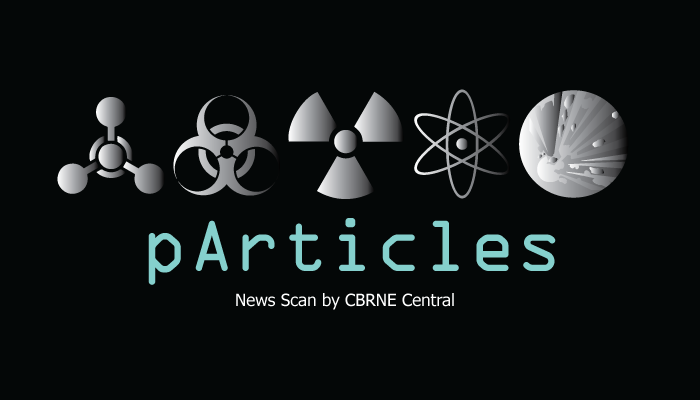Topics in this issue include treating veterans exposed to hazards, nuclear plant radiation monitoring technologies, and next-generation sequencing in forensic labs.
In This Article
Hazmat & Facility Incidents
California Methane Leak ‘Largest in US History’
A scientific analysis of a natural gas leak near Los Angeles says that it was the biggest in US history. The Aliso Canyon blowout vented almost 100,000 ton of methane into the atmosphere before it was plugged. The impact on the climate is said to be the equivalent of the annual emissions of half a million cars. BBC News >>
Agency Seeks $700,000 to Study Dioxane Plume in Ann Arbor
The Michigan Department of Environmental Quality wants $700,000 to better monitor, track and understand a dioxane plume that slowly has been expanding in Ann Arbor. The agency has asked state lawmakers to approve the allocation of Clean Michigan Initiative funds in fiscal year 2017, which starts in October, The Ann Arbor News reported. Dioxane is considered a probable human carcinogen. Chem.info >>
Nuclear Security
The Nuclear Security Summit Will Leave Unfinished Work
Laura Holgate, the US envoy to the Nuclear Security Summit, likes to compare the series of biannual meetings initiated by President Barack Obama in 2010 to a “sprint in the middle of a marathon.” The metaphor is an apt one. Like sprinters, summit participants moved quickly to achieve some concrete accomplishments, departing from the usual languid pace of multilateral diplomacy. Bulletin of the Atomic Scientists >>
PBS Newshour Takes on the Holy Nuclear Triad
It has almost become dogma: The United States needs to keep a Triad of strategic nuclear forces. Therefore, expensive modernization of every leg is necessary plus a fourth leg of non-strategic fighter-jets. Oh, and don’t forget nuclear command and control systems such as terminals and satellites. Federation of American Scientists >>
Forensics
Putting NGS into Practice: Q&A for Forensic Labs
Next-Generation Sequencing (NGS), also known as Massively Parallel Sequencing (MPS), is potentially game changing for forensic labs and the criminal justice system. However, putting NGS into place requires labs to adopt new technologies, processes and methods. Forensic Magazine >>
Expansion of Microbial Forensics
Microbial forensics has been defined as the discipline of applying scientific methods to analyzing evidence related to bioterrorism, biocrimes, hoaxes, or the accidental release of a biological agent or toxin for attribution purposes. Over the past 15 years technology, particularly massively parallel sequencing, and bioinformatics advances now allow characterization of microorganisms for a variety of human forensic applications. Journal of Microbiology >>
Military Health
Lawmaker to Pitch New Veterans Center for Hazardous Exposures
Rep. Tim Walz, D-Minn., plans to introduce legislation Thursday to create a “center of excellence” to study and manage medical care for veterans with illnesses caused by chemicals and other battlefield environmental hazards. Walz will propose a “Center of Excellence for Toxic Wounds,” managed by the Veterans Affairs Department, that would provide a one-stop shop for research initiatives, health care treatment policy and guidance, and specialty care for chronic illnesses linked to exposures resulting from military service. Navy Times >>
Gulf War Vets Recall Friendly Fire, Chemical Weapons and Patriotism
The 19-year-old Army private from Shafter stood in a Saudi Arabia port, gas mask clasped over his face, hunting for reasons not to think he was being poisoned. If the seagulls were flying, it meant the chemical weapons alarm making his heart race was a false alert. “If the birds were falling” he said, “it was legit.” This was Operation Desert Storm. Ventura County Star >>
First Responders
Emergency Management Personnel Get Green Light to Carry Firearms
Sometimes Office of Emergency Management personnel are the first to arrive at the scenes of disasters, which can be late at night in secluded areas. They also work long hours, as the situation requires. County commissioners said they wanted to give the emergency management personnel the opportunity to defend themselves, should it ever be necessary. Emergency Management >>
Paramedics Offered Insight Into New Career with HART Team
Paramedics from the West Midlands Ambulance Service were given an insight into what a new career in the Hazardous Area Response Team (HART) would be like as they tried out to become a member of the specialist unit. HART teams provide paramedic care to patients within a hazardous environment that would otherwise be beyond the reach of NHS care. Coventry Observer >>
DHS Predicts Uptick in Cyber Targeting of Emergency Services
As emergency services sector communications and networked systems evolve, a wider array of attack vectors are available for cyber targeting, said the Homeland Security Department’s office of intelligence and analysis. “Such vulnerable systems include call-center communications-management software, closed-circuit TV camera systems, interactive voice response systems, and emergency alert systems – particularly wireless emergency alert systems,” said report authors. FierceGovernmentIT >>
Nuclear Safety & Facilities
Winds Blow Small Amount of Radiation Onto Washington Highway
The uncontrolled spread of small amounts of radioactive waste at Hanford after a Nov. 17 windstorm is alarming, the U.S. Environmental Protection Agency said in a letter to the Department of Energy. The high winds pushed specks of contamination beyond Route 4, a public highway in Richland to the Wye Barricade entrance to Hanford. Chem.info >>
Fukushima Disaster: Tepco Admits Late Meltdown Announcement
The operator of the Fukushima nuclear power plant hit by a tsunami in 2011 has admitted that it should have announced sooner that there was a nuclear meltdown at the site. It was two months before it was acknowledged there had been a meltdown. BBC >>
Why America Pays More for Nuclear Power
As countries scramble to grow their supply of clean energy, nuclear power poses a couple of problems. Radiation risks are unavoidable, of course, and the conventional wisdom says that, unlike other energy sources, nuclear is doomed to grow increasingly expensive over time. In the U.S., costs have skyrocketed so high that hardly any new plants get built anymore. CityLab >>
General Atomics to Provide Radiation Monitoring Tech at US Nuclear Plants
General Atomics will provide radiation monitoring systems to help U.S. nuclear power plants that use boiling water reactors with Mark I and II containments comply with Nuclear Regulatory Commission safety mandates. GovConWire >>



